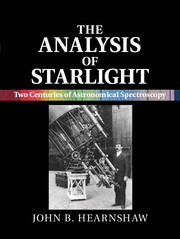Book contents
- Frontmatter
- Contents
- Preface to the second edition
- Preface to the first edition, 1986
- Acknowledgements
- 1 Introduction to spectroscopy, spectroscopes and spectrographs
- 2 The analysis of sunlight: the earliest pioneers
- 3 The foundations of spectral analysis: from Fraunhofer to Kirchhoff
- 4 Early pioneers in stellar spectroscopy
- 5 Spectral classification at Harvard
- 6 The Doppler effect
- 7 The interpretation of stellar spectra and the birth of astrophysics
- 8 Spectral classification: From the Henry Draper Catalogue to the MK system and beyond
- 9 Spectroscopy of peculiar stars
- 10 Quantitative analysis of stellar spectra
- 11 Some miscellaneous topics in stellar spectroscopy: individual stars of note, stellar chromospheres, interstellar lines and ultraviolet spectroscopy from space
- Figure sources and acknowledgements
- Appendix A List of solar lines designated by letters by Fraunhofer and others
- Appendix B Vogel's first spectral classification scheme of 1874
- Index of names
- Index of star names
- Index of spectral lines
- Index of subjects
- References
5 - Spectral classification at Harvard
Published online by Cambridge University Press: 05 April 2014
- Frontmatter
- Contents
- Preface to the second edition
- Preface to the first edition, 1986
- Acknowledgements
- 1 Introduction to spectroscopy, spectroscopes and spectrographs
- 2 The analysis of sunlight: the earliest pioneers
- 3 The foundations of spectral analysis: from Fraunhofer to Kirchhoff
- 4 Early pioneers in stellar spectroscopy
- 5 Spectral classification at Harvard
- 6 The Doppler effect
- 7 The interpretation of stellar spectra and the birth of astrophysics
- 8 Spectral classification: From the Henry Draper Catalogue to the MK system and beyond
- 9 Spectroscopy of peculiar stars
- 10 Quantitative analysis of stellar spectra
- 11 Some miscellaneous topics in stellar spectroscopy: individual stars of note, stellar chromospheres, interstellar lines and ultraviolet spectroscopy from space
- Figure sources and acknowledgements
- Appendix A List of solar lines designated by letters by Fraunhofer and others
- Appendix B Vogel's first spectral classification scheme of 1874
- Index of names
- Index of star names
- Index of spectral lines
- Index of subjects
- References
Summary
Edward Pickering at Harvard College Observatory
So far only occasional reference has been made to the work in stellar spectroscopy at Harvard College Observatory in Cambridge, Massachusetts. However, the developments that took place there from 1885 are so important that they merit a separate chapter. The action took place over a period of four decades from this date, and five actors filled the leading roles. Four of these were women. The part played by Professor Edward C. Pickering in the development of Harvard stellar spectroscopy was, however, the most significant.
Pickering (Fig. 5.1) came from a prominent New England family, and his brother (William Pickering (1858–1938)) was also a physicist and astronomer of some note (he was an assistant professor in astronomy at Harvard from 1887). The fact that Edward Pickering was appointed to a chair as Professor of Physics at the Massachusetts Institute of Technology (MIT) at the age of only 22 shows that his scientific abilities were already manifest in comparative youth. His research at MIT was mainly in the field of optics, although astronomy was also an interest, as he took part in solar eclipse expeditions in both 1869 and 1870.
After nine years as an MIT professor, Pickering was appointed director of Harvard College Observatory, where he took up his duties in February 1877. Apparently the appointment of a physicist provoked some criticism, as several able astronomers were also candidates.
- Type
- Chapter
- Information
- The Analysis of StarlightTwo Centuries of Astronomical Spectroscopy, pp. 63 - 85Publisher: Cambridge University PressPrint publication year: 2014

